ABOUT 3535 air training command
- Origins: The 3535th Air Training Wing (later Air Training Group/Command) was activated in 1949 at Mather Air Force Base, California, and played a pivotal role in USAF navigator and electronic warfare officer training.
- Core Mission: The unit’s primary mission was to conduct advanced training for navigators, radar observers, and later, electronic warfare officers, who were essential crew members on bombers and reconnaissance aircraft during the Cold War.
- Aircraft Variety: The 3535th flew a diverse fleet, including the Convair T-29 "Flying Classroom," Boeing B-25 Mitchell, T-33 Shooting Star, T-43, and EC-135, all tailored for advanced navigation and electronic warfare training.
- Cold War Importance: The unit’s graduates crewed key strategic bombers (like the B-52 Stratofortress) and reconnaissance aircraft, forming a critical backbone of SAC and global USAF operations during the height of the Cold War.
- International Training: Allied officers from nations such as Canada, Saudi Arabia, and NATO partners attended courses at Mather AFB, making the 3535th a hub for international aviation collaboration.
- Massive Output: At its peak, the 3535th graduated thousands of navigators annually, making it one of the world’s largest navigation schools.
- Women in the Cockpit: In the 1970s, the 3535th trained some of the first female USAF navigators, marking a significant milestone in Air Force gender integration.
- Vietnam War Service: Many of the unit’s graduates served as navigators and electronic warfare officers in Southeast Asia, flying combat missions on B-52s, C-130s, and EB-66 aircraft.
- End of an Era: The 3535th was inactivated in 1993 after the closure of Mather AFB, ending over four decades of continuous navigator and EWO training at that location.
- Legacy: The traditions and mission of the 3535th live on through successor units and alumni, many of whom went on to senior leadership roles in the USAF and aviation industry.


.jpg)


